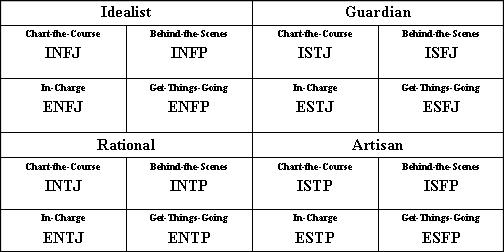Book Review by Jack Falt, INFJ
Linda Berens has been working on this best fit problem for many years. Her early training with David Keirsey led her to see that temperament was a key to tapping into our core needs. David Keirsey further discovered that there seemed to be four kinds of roles within each of the four temperaments. There were initiating and responding roles, and there were directing and informing roles. Combined into a matrix they formed the four interaction styles: Chart-the-Course, Behind-the-Scenes, In-charge, and Get-Things-Going.
The Four Temperaments
|
|
|
|
|
|
The Four Interaction Styles
|
|
|
|
| Responding |
|
|
| Initiating |
|
|
When the interaction styles matrix was placed into each square of the temperament matrix, it produced sixteen separate patterns that were the sixteen psychological types. This was developed into the Temperament Matrix™ way of organizing the sixteen types rather than using the traditional type table format.
Temperament Matrix™ of the 16 Types

When looking at each interaction style and the four types it shared (e.g. Chart-the-Course = INFJ + ISTJ + ISTP + INTJ), the results seemed to be similar to the DiSC® instrument (Marston/Geier). Berens worked at refining these four styles and developing a program to help people determine their interaction styles. This booklet provides the theory and styles descriptions to be a support to the interaction styles portion of the Self-Discovery Process.
Just as temperament and type are believed to be inborn, so are interaction styles. The facilitator of the Self-Discovery Process uses a combination of explanation and activities to help people determine their interaction style. People are then asked to read the appropriate interaction style description and see how well it fits their way of interacting with others.
The booklet begins with some history of interaction style patterns. It looks at the nature of interaction styles and how they are inborn. Although we are born with one style, we are able to learn to use all styles when they are needed. This versatility can sometimes make the process of determining one’s style a little more difficult because more than one style seems to fit because we have learned to use the other styles depending on the context of the situation.
There are exercises to help people determine their own styles. For each interaction style there are two page style descriptions with one page giving examples of people describing themselves using this style and the second page giving a third person portrait of the style.
Just as the temperaments have things in common with one another so do the styles. By being aware of these similarities, it can help people find a better fit of interaction style.
In presenting temperaments Berens represented each of them as a target showing needs, values, talents and behaviours. For interaction styles each of them is represented as an arrow showing drive, core beliefs, aim, attributes and talents.
Understanding about interaction styles can be quite useful when we need to shift our perspective. When we are trying to communicate with others, we often realize that we aren’t getting our message across. We need to shift our perspective and communicate in the other person’s interaction style. There is an excellent chart giving pointers on how each style communicates.
We are familiar with Naomi Quenk’s “in the grip” way of understanding stress in the sixteen types, and there is also the work of Dr. Sue Cooper on stress experienced by the four temperaments. This booklet identifies the stress each interaction style will likely experience and how to cope with it.
For those not familiar with using temperament and interaction styles to help get a better type fit, the Self-Discovery Process is very interesting, and the interaction styles fill in a missing piece of the puzzle. This booklet does an excellent job of fleshing out what interaction styles are and how one goes about discovering them.
I recently took the TRI Methodology™ training with Linda Berens and Scott Campbell. I wanted to be able to use the Self-Discovery Process™ I had taken the temperament and cognitive processes portions previously as a participant from Linda; but the interaction styles portion was new to me, and it was the highlight of the training for me.
I recommend that people find out about interaction styles and incorporate them into their basic Jung/Myers theory presentations. It can give them yet another tool to help relate type to other models and simpler ways to get into type when time is short.